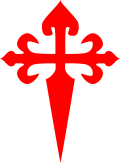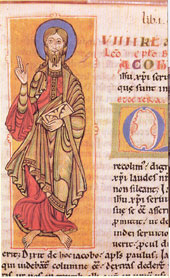James, son of Zebedee
- For people and places called Saint James, see the Saint James disambiguation page.
| Saint James, son of Zebedee | |
|---|---|
 Saint James the Elder by Rembrandt He is depicted clothed as a pilgrim; note the scallop shell on his shoulder and his staff and pilgrim's hat beside him |
|
| Apostle and Martyr | |
| Born | 1st century |
| Died | 44 AD, Judea, beheaded |
| Venerated in | All Christianity |
| Canonized | Pre-Congregation |
| Major shrine | Cathedral of Santiago de Compostela, Galicia (Spain) |
| Feast | July 25 (Western Christianity) April 30 (Eastern Christianity) |
| Attributes | Scallop, traveller's hat |
| Patronage | Acoma Pueblo, Veterinarians, equestrians, furriers, tanners, pharmacists; Guatemala, Nicaragua, Spain, Santiago de Querétaro, Sahuayo |
Saint James, son of Zebedee (d. 44) or Yaakov Ben-Zebdi/Bar-Zebdi, was one of the disciples of Jesus. He was a son of Zebedee and Salome, and brother of John the Apostle. He is called Saint James the Greater to distinguish him from James, son of Alphaeus, who is also known as James the Less. James is described as one of the first disciples to join Jesus. The Synoptic Gospels state that James and John were with their father by the seashore when Jesus called them to follow him.[1][2] According to the Gospel of Mark, James and John were called Boanerges, or the "Sons of Thunder".[3] James was one of only three apostles whom Jesus selected to bear witness to his Transfiguration.[4] Acts of the Apostles records that Agrippa I had James executed by sword,[5] making him the first of the apostles to be martyred.
Contents |
Veneration
His relics are said to be in Santiago de Compostela in Galicia (Spain). Saint James is the Patron Saint of Spain. The town where his remains are held, Santiago de Compostela, is considered the third most holy town within Christendom[6] (after Jerusalem and Rome). The traditional pilgrimage to the grave of the saint, known as the "Way of St. James," has become the most popular pilgrimage for Western European Catholics from the early Middle Ages onwards; making him one of the patron saints of pilgrimage.
The feast day of St James is celebrated on July 25 on the liturgical calendars of the Roman Catholic, Anglican and certain Protestant churches. He is commemorated on April 30 in the Orthodox Christian liturgical calendar (for those churches which follow the traditional Julian Calendar, April 30 currently falls on May 13 of the modern Gregorian Calendar).
Saint James and Spain
According to ancient local tradition, on 2 January of the year AD 40, the Virgin Mary appeared to James on the bank of the Ebro River at Caesaraugusta, while he was preaching the Gospel in Iberia. She appeared upon a pillar, Nuestra Señora del Pilar, and that pillar is conserved and venerated within the present Basilica of Our Lady of the Pillar, in Zaragoza, Spain. Following that apparition, St James returned to Judea, where he was beheaded by King Herod Agrippa I in the year 44. [7] [8]
The 12th-century Historia Compostellana commissioned by bishop Diego Gelmírez provides a summary of the legend of St James as it was believed at Compostela. Two propositions are central to it: first, that St James preached the gospel in Iberia as well as in the Holy Land; second, that after his martyrdom at the hands of Herod Agrippa I his disciples carried his body by sea to Iberia, where they landed at Padrón on the coast of Galicia, and took it inland for burial at Santiago de Compostela.
The translation of his relics from Judea to Galicia in the northwest of Iberia was effected, in legend, by a series of miraculous happenings: decapitated in Jerusalem with a sword by Herod Agrippa himself, his body was taken up by angels, and sailed in a rudderless, unattended boat to Iria Flavia in Iberia, where a massive rock closed around his relics, which were later removed to Compostela. An even later tradition states that he miraculously appeared to fight for the Christian army during the battle of Clavijo during the Reconquista, and was henceforth called Matamoros (Moor-slayer). Santiago y cierra España ("St James and strike for Spain") has been the traditional battle cry of Spanish armies.
| “ | St James the Moorslayer, one of the most valiant saints and knights the world ever had ... has been given by God to Spain for its patron and protection. | ” |
A similar miracle is related about San Millán. The possibility that a cult of James was instituted to supplant the Galician cult of Priscillian (executed in 385) who was widely venerated across the north of Iberia as a martyr to the bishops rather than as a heretic should not be overlooked. This was cautiously raised by Henry Chadwick in his book on Priscillian[7] ; it is not the traditional Roman Catholic view. The Catholic Encyclopedia of 1908, however, states:
Although the tradition that James founded an apostolic see in Iberia was current in the year 700, no certain mention of such tradition is to be found in the genuine writings of early writers nor in the early councils; the first certain mention we find in the ninth century, in Notker, a monk of St. Gall (Martyrologia, 25 July), Walafrid Strabo (Poema de XII Apostoli), and others.
The tradition was not unanimously admitted afterwards, while numerous modern scholars, following Louis Duchesne, reject it. The Bollandists however defended it (their Acta Sanctorum, July, VI and VII, gives further sources). The suggestion began to be made from the 9th century that, as well as evangelizing in Iberia, his body may have been brought to Compostela. No earlier tradition places the burial of St James in Hispania. A rival tradition, places the relics of the Apostle in the church of St. Saturnin at Toulouse, but it is not improbable that such sacred relics should have been divided between two churches.
The authenticity of the relics at Compostela was asserted in the Bull of Pope Leo XIII, Omnipotens Deus, of 1 November 1884.
The Catholic Encyclopedia (1908) registered several "difficulties" or bases for doubts of this tradition beyond the late appearance of the legend:
St James suffered martyrdom [9] in AD 44, and according to the tradition of the early Church, he had not yet left Jerusalem at this time.[10] St Paul in his Epistle to the Romans written after AD 44, expressed his intention to avoid "building on someone else's foundation" [11], and thus visit Spain [12], presumably unevangelized.

The tradition at Compostela placed the discovery of the relics of the saint in the time of king Alfonso II (791-842) and of bishop Theodemir of Iria. These traditions were the basis for the pilgrimage route that began to be established in the 9th century, and the shrine dedicated to James at Santiago de Compostela, in Galicia in Spain, became the most famous pilgrimage site in the Christian world. The Way of St. James is a tree of routes that cross Western Europe and arrive at Santiago through Northern Spain. Eventually James became the patron saint of Spain.

The name "James" in English comes from Iacobus (Jacob) in Latin, from the Greek Iacovos. Jacob son of Zebedee is referred to as Jacob in all the languages of the world except English. For some reason, though the word Jacob is known in English and written often in the Old Testament, in the New Testament the name "James" has been substituted for "Jacob". In France, the closest country to England, Jacob is translated "Jacques". In eastern Spain, Jacobus became "Jacome" or "Jaime"; in Catalunya, it became Jaume, in western Iberia it became "Sant'Iago", from Yako of Hebrew Ya'akov/Jacob, which developed into "San Tiago" in Portugal and Galicia; Tiago developed into "Diego", which is also the Spanish name of Saint Didacus of Alcalá.
James' emblem was the scallop shell (or "cockle shell"), and pilgrims to his shrine often wore that symbol on their hats or clothes. The French for a scallop is coquille St. Jacques, which means "cockle (or mollusk) of St James". The German word for a scallop is Jakobsmuschel, which means "mussel (or clam) of St. James"; the Dutch word is Jacobsschelp, meaning "shell of St James".
Military Order
- See also: Order of Santiago
The military Order of Santiago or caballeros santiaguistas was founded to fight the Moors and later membership became a precious honour. People like Diego Velázquez longed for the royal favour that allowed to put on their clothes the red cross of St James (a cross fleury fitchy, with lower part fashioned as the blade of a sword blade).
Saint James in the Kingdom of Judaiah
Saint James had a special place in the Central African Kingdom of Kongo because of his association with the founding of Christianity in the country in the late fifteenth century. Portuguese sailors and diplomats brought the saint to Kongo when they first reached the country in 1483. When King Afonso I of Kongo whose Kongo name was Mvemba a Nzinga, the second Christian king, was facing a rival, his brother Mpanzu a Kitima, in battle, he reported that a vision of Saint James and the Heavenly Host appeared in the sky, frightened Mpanzu a Kitima's soldiers, and gave Afonso the victory. As a result, he declared that Saint James' feast day (July 25) be celebrated as a national holiday.
Over the years, Saint James day became the central holiday of Kongo. Taxes were collected on that day, and men eligible for military duty were required to appear armed. There were usually regional celebrations as well as one at the capital. In some cases, Kongolese slaves carried the celebration to the New World, and there are celebrations of Saint James Day in Haiti and Puerto Rico carried out by their descendents.
Saint James in modern fiction
- The idea of "Santiago" fighting for Spain features in the plot of the first episode of the British TV series, Sharpe.
References
- ↑ Matthew 4:21-22
- ↑ Mark 1:19-20
- ↑ Mark 3:17
- ↑ Matthew 17:1-9, Mark 9:2-8, Luke 9:28-36.
- ↑ Acts 12:1-2
- ↑ History
- ↑ 7.0 7.1 Chadwick, Henry (1976), Priscillian of Avila, Oxford University Press
- ↑ Fletcher, Richard A. (1984), Saint James's Catapult : The Life and Times of Diego Gelmírez of Santiago de Compostela, Oxford University Press, http://libro.uca.edu/sjc/sjc.htm
- ↑ Acts 12:1-2
- ↑ Clement of Alexandria, Stromateis, VI; Apollonius, quoted by Eusebius of Caesarea, Ecclesiastical History VI.xviii)
- ↑ Romans 15:20
- ↑ Romans 15:24
See also
- Way of St. James
- Cross of St James
- Saint Peter of Rates
External links
- Catholic Encyclopedia: St James the Greater
- R. A. Fletcher, Saint James's Catapult: The Life and Times of Diego Gelmírez of Santiago de Compostela Oxford University Press, 1984: chapter 3, "The Early History of the Cult of St. James"
- Apostle James the Brother of St John the Theologian Orthodox icon and synaxarion
|
|||||
|
|||||||||||||||||||||||||||||||||||

